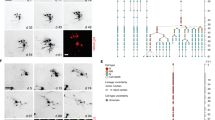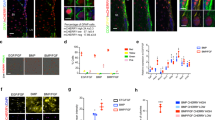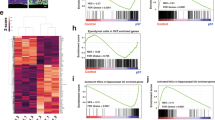Abstract
Sonic hedgehog (Shh) has been implicated in the ongoing neurogenesis in postnatal rodent brains1,2. Here we adopted an in vivo genetic fate-mapping strategy, using Gli1 (GLI-Kruppel family member) as a sensitive readout of Shh activity, to systematically mark and follow the fate of Shh-responding cells in the adult mouse forebrain. We show that initially, only a small population of cells (including both quiescent neural stem cells and transit-amplifying cells) responds to Shh in regions undergoing neurogenesis. This population subsequently expands markedly to continuously provide new neurons in the forebrain. Our study of the behaviour of quiescent neural stem cells provides in vivo evidence that they can self-renew for over a year and generate multiple cell types. Furthermore, we show that the neural stem cell niches in the subventricular zone and dentate gyrus are established sequentially and not until late embryonic stages.
This is a preview of subscription content, access via your institution
Access options
Subscribe to this journal
Receive 51 print issues and online access
$199.00 per year
only $3.90 per issue
Buy this article
- Purchase on SpringerLink
- Instant access to full article PDF
Prices may be subject to local taxes which are calculated during checkout




Similar content being viewed by others
References
Lai, K., Kaspar, B. K., Gage, F. H. & Schaffer, D. V. Sonic hedgehog regulates adult neural progenitor proliferation in vitro and in vivo. Nature Neurosci. 6, 21–27 (2003)
Machold, R. et al. Sonic hedgehog is required for progenitor cell maintenance in telencephalic stem cell niches. Neuron 39, 937–950 (2003)
Doetsch, F. The glial identity of neural stem cells. Nature Neurosci. 6, 1127–1134 (2003)
Alvarez-Buylla, A. & Garcia-Verdugo, J. M. Neurogenesis in adult subventricular zone. J. Neurosci. 22, 629–634 (2002)
Gage, F. H. Mammalian neural stem cells. Science 287, 1433–1438 (2000)
Alvarez-Buylla, A. & Lim, D. A. For the long run: maintaining germinal niches in the adult brain. Neuron 41, 683–686 (2004)
Bai, C. B., Auerbach, W., Lee, J. S., Stephen, D. & Joyner, A. L. Gli2, but not Gli1, is required for initial Shh signalling and ectopic activation of the Shh pathway. Development 129, 4753–4761 (2002)
Bai, C. B., Stephen, D. & Joyner, A. L. All mouse ventral spinal cord patterning by Hedgehog is Gli dependent and involves an activator function of Gli3. Dev. Cell 6, 103–115 (2004)
Doetsch, F., Caille, I., Lim, D. A., Garcia-Verdugo, J. M. & Alvarez-Buylla, A. Subventricular zone astrocytes are neural stem cells in the adult mammalian brain. Cell 97, 703–716 (1999)
Seri, B., Garcia-Verdugo, J. M., McEwen, B. S. & Alvarez-Buylla, A. Astrocytes give rise to new neurons in the adult mammalian hippocampus. J. Neurosci. 21, 7153–7160 (2001)
Doetsch, F., Petreanu, L., Caille, I., Garcia-Verdugo, J. M. & Alvarez-Buylla, A. EGF converts transit-amplifying neurogenic precursors in the adult brain into multipotent stem cells. Neuron 36, 1021–1034 (2002)
Hack, M. A., Sugimori, M., Lundberg, C., Nakafuku, M. & Gotz, M. Regionalization and fate specification in neurospheres: the role of Olig2 and Pax6. Mol. Cell. Neurosci. 25, 664–678 (2004)
Ahn, S. & Joyner, A. L. Dynamic changes in the response of cells to positive hedgehog signalling during mouse limb patterning. Cell 118, 505–516 (2004)
Zervas, M., Millet, S., Ahn, S. & Joyner, A. L. Cell behaviors and genetic lineages of the mesencephalon and rhombomere 1. Neuron 43, 345–357 (2004)
Doetsch, F., Garcia-Verdugo, J. M. & Alvarez-Buylla, A. Regeneration of a germinal layer in the adult mammalian brain. Proc. Natl Acad. Sci. USA 96, 11619–11624 (1999)
Palmer, T. D., Takahashi, J. & Gage, F. H. The adult rat hippocampus contains primordial neural stem cells. Mol. Cell. Neurosci. 8, 389–404 (1997)
Gage, F. H., Kempermann, G., Palmer, T. D., Peterson, D. A. & Ray, J. Multipotent progenitor cells in the adult dentate gyrus. J. Neurobiol. 36, 249–266 (1998)
Suhonen, J. O., Peterson, D. A., Ray, J. & Gage, F. H. Differentiation of adult hippocampus-derived progenitors into olfactory neurons in vivo. Nature 383, 624–627 (1996)
Herrera, D. G., Garcia-Verdugo, J. M. & Alvarez-Buylla, A. Adult-derived neural precursors transplanted into multiple regions in the adult brain. Ann. Neurol. 46, 867–877 (1999)
Yoon, S. O. et al. Adenovirus-mediated gene delivery into neuronal precursors of the adult mouse brain. Proc. Natl Acad. Sci. USA 93, 11974–11979 (1996)
Doetsch, F., Garcia-Verdugo, J. M. & Alvarez-Buylla, A. Cellular composition and three-dimensional organization of the subventricular germinal zone in the adult mammalian brain. J. Neurosci. 17, 5046–5061 (1997)
Kuhn, H. G., Dickinson-Anson, H. & Gage, F. H. Neurogenesis in the dentate gyrus of the adult rat: age-related decrease of neuronal progenitor proliferation. J. Neurosci. 16, 2027–2033 (1996)
Kempermann, G., Gast, D., Kronenberg, G., Yamaguchi, M. & Gage, F. H. Early determination and long-term persistence of adult-generated new neurons in the hippocampus of mice. Development 130, 391–399 (2003)
Berman, D. M. et al. Widespread requirement for Hedgehog ligand stimulation in growth of digestive tract tumours. Nature 425, 846–851 (2003)
Karhadkar, S. S. et al. Hedgehog signalling in prostate regeneration, neoplasia and metastasis. Nature 431, 707–712 (2004)
Watkins, D. N. et al. Hedgehog signalling within airway epithelial progenitors and in small-cell lung cancer. Nature 422, 313–317 (2003)
Arnett, H. A. et al. bHLH transcription factor Olig1 is required to repair demyelinated lesions in the CNS. Science 306, 2111–2115 (2004)
Acknowledgements
We would like to thank J. Wolf, K. Harper, D. Stephens, O. Aristizabal and R. Turnbull for technical assistance; M. Fuccillo for experimental advice; P. Soriano for R26R mice; D. Rowitch and C. Stiles for the anti-Olig2 antibody; G. Fishell for his insightful input throughout the project, and M. Zervas and S. Blaess for critical reading of the manuscript. S.A. is supported by a NIH National Research Service Award postdoctoral fellowship and A.L.J. is a Howard Hughes Medical Institute investigator.
Author information
Authors and Affiliations
Corresponding author
Ethics declarations
Competing interests
Reprints and permissions information is available at npg.nature.com/reprintsandpermissions. The authors declare no competing financial interests.
Supplementary information
Supplementary Figure 1
Transit-amplifying cells respond to Shh signaling in the SVZ as evidenced by their double labeling of lacZ (red) and Olig2 (green). (JPG 229 kb)
Supplementary Figure 2
Dlx2+ transit-amplifying cells are greatly diminished one week after AraC treatment in the rostral migratory stream (RMS) and SVZ. (JPG 229 kb)
Supplementary Figure 3
The ability of Shh-responding stem cells to regerminate repetitively was demonstrated by multiple administration of AraC. (JPG 356 kb)
Supplementary Figure 4
Shh-responding neural stem cells generate interneurons of the olfactory bulb: GABAergic and dompaminergic periglomerular neurons and GABAergic granule neurons. (JPG 286 kb)
Supplementary Table 1
Fate mapped Shh-responding cells were quantified for their co-expression of markers for neurons, astrocytes, and oligodendrocytes in the SVZ and DG. (PDF 78 kb)
Supplementary Notes
Supplementary Figure Legends and Supplementary Methods. (PDF 60 kb)
Rights and permissions
About this article
Cite this article
Ahn, S., Joyner, A. In vivo analysis of quiescent adult neural stem cells responding to Sonic hedgehog. Nature 437, 894–897 (2005). https://doi.org/10.1038/nature03994
Received:
Accepted:
Issue Date:
DOI: https://doi.org/10.1038/nature03994



